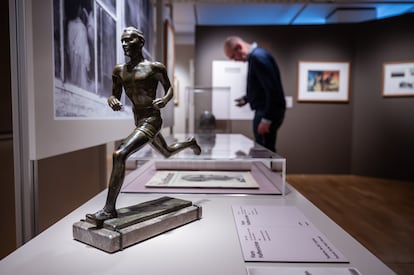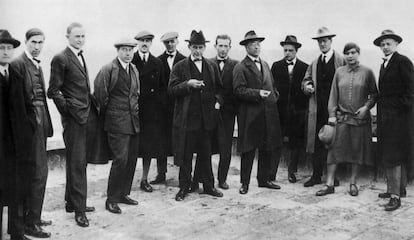Not just heroes: The renowned Bauhaus art school also collaborated with the Nazis
A Weimar exhibition reveals that dozens of professors and students at the school, a hotbed of artistic vanguard in 1930s Germany, were members of the party or accepted commissions from the Third Reich

Behind the heroic façade of the Bauhaus, erected with the ideals of the artistic vanguard and political resistance, hides a complex and little-known history of the ambiguous relationship between some of its members and the Nazis. Shut down by Hitler’s regime, the school of design, architecture and applied arts is remembered as a center of leftist resistance, as a refugee for martyrs who were labelled as “degenerate artists” by the Third Reich and condemned to exile and the end of their professional careers or even their lives. A new exhibition in Weimar, the German town where the Bauhaus was founded by Walter Gropius in 1919, tells a different story, though, one of tacit collusion and explicit collaboration.
Based on a three-year investigation, the Bauhaus and National Socialism exhibition, which runs through September 15, provides a reminder that many of the professors and students that passed through the school’s halls continued their work with no interruptions after the 1933 Nazi victory. They didn’t hesitate to accept commissions from the regime, out of necessity or conviction; they designed posters, furniture and household goods, not to mention creating portraits of Hitler and pieces that presented allegories of an eternal and pure Germany. In some cases, they were even active members of the Nazi Party and the Schutzstaffel (SS). The numbers are devastating: of the school’s 1,400 constituents, at least 900 remained in Germany under the Third Reich. Only 130 fled the country after Hitler’s victory at the polls, while some 188 decided to join the Nazi Party.

Through 450 works and objects, the exhibition explores the Bauhaus’s ambiguous relationship with the Nazis, and vice versa. The party closed the school in 1933, after moving it to Dessau and then to Berlin, and banned many of its artists from showing their works in public, considering them attacks on beauty and potential vehicles of Bolshevism. “But, not without a certain schizophrenism, the Nazis also used these artists, designers and architects to project the image of a sophisticated and modern state, above all in the eyes of foreigners,” says the exhibition’s curator Anke Blümm. After initially rejecting them, the Third Reich took advantage of the artistic representatives of a movement that, after all, was in keeping with the Nazi taste for art without ornamentation.
The curator believes that enough time has passed for the myth of an immaculate Bauhaus to be dismantled. “Beginning in the 1950s, an image was established of the school as a refuge for Socialists and Jews, ignoring accounts that did not square with that legend. In the post-war context, many Germans wanted to believe that all of its members were heroes. We are the third generation to come after the Holocaust and we have the necessary distance to look this reality in the face,” says Blümm.

From the beginning, Nazis paid particular attention to modern art. In 1930, when they gained a foothold in Thuringia’s state government, the party banned the works of the school’s leaders. Seven years later, the Nazis confiscated several hundred paintings and sculptures, some of which are now on display in one of the exhibition’s galleries. An apparently inoffensive floral watercolor, signed by Klee and owned by the MoMA, has returned to Weimar, a hotbed of culture and homeland of Goethe and Schiller, as has an abstract Kandinsky and a constructivist Moholy-Nagy. The show, which is divided into three distinct sections, contrasts these with the art that the Nazis did favor. Wilhelm Imkamp, former member of the Bauhaus, had a predilection for inane portraits of old women, while Heinrich Basedow, who was also a teacher at the school, abandoned abstraction to paint kitsch seagulls. Hans Haffenrichter designed diminutive statues of animals before undertaking a bust of Hitler.
In total, 16 of the school’s professors and students participated in the large Munich art exhibition organized by the Nazis in 1937. Among the former members of the Bauhaus who were members of the party are designer Karl Peter Röhl, architect Friedrich Karl Engemann and artist Lili Schultz, who appeared in photos wearing Nazi uniforms or alongside party officials. Ernst Neufert, the author of an architectural reference manual who was Gropius’s right hand, collaborated with Albert Speer, official architect of the Third Reich. Artist Oskar Schlemmer participated in a public contest to create a fresco in which appeared characters executing the Nazi salute, while Fritz Ertl, an architect who became SS during the war, designed Auschwitz’s so-called “washhouses,” crematoriums used to dispose of cadavers. He was acquitted in 1972 after saying that he didn’t know what his designs would be used for; he had only applied what he’d learned at the Bauhaus to follow the orders he’d received. The banality of evil, in its architectural form.

For his part, Franz Ehrlich, who was imprisoned as a Communist sympathizer, didn’t flinch from collaborating to save himself. He designed the entrance gates at Buchewald, a concentration camp location outside of Weimar, with the same fonts that were used by the Bauhaus. He later designed furnishings for the homes of various party officials and even built a guest house for Nazi leader Hermann Göring. At the other extreme, 24 members of the Bauhaus were deported and murdered in camps, like the painter Friedl Dicker-Brandeis and textile artist Otti Berger. There was no escape for the latter — she was a deaf Communist Jew.
The exhibition also mentions the school’s best-known figures, who had an ambivalent attitude, sometimes out of their own interest, being reluctant to undertake the life of the exile. Gropius himself, who is suspected of antisemitism, was a member of the Chamber of Culture founded by Goebbels and participated in an architecture contest organized by the Nazis. In 1934, he designed a pavilion for the propagandistic German People-German Labor exhibition, as did Mies van der Rohe, who was the director of the Bauhaus from 1930 to 1933 before expatriating to the United States. But the majority of the Bauhaus creatives preferred to adapt to the country’s new conditions. “Not everyone had the money to go into exile, they had to feed their families and after all, this was their birth country,” says Blümm. “It was easy to make do by working as graphic designers. It wasn’t the same as killing someone, they thought. They were young and naïve.”

Still, the show includes examples that reflect large doses of voluntary ignorance. For example, there’s the case of Herbert Bayer. The great designer and typographer of the Bauhaus, who favored lowercase and sans serif lettering, was not suspected of having any Nazi affiliation: he was married to a Jew and had many Jewish friends. Still, he agreed to design posters for the regime in which appear the iron cross, another for an association of “Aryan textile workers” and a third for an ad defending the sterilization of erbkranken, a category used by the Nazis to classify “genetically inferior” individuals such as people with disabilities. In 1938, Bayer self-exiled to Aspen, where he began a new life making advertisements for ski resorts. When he was reminded of that uncomfortable life chapter, he would respond by saying he made an error in thinking that art could be apolitical.
Sign up for our weekly newsletter to get more English-language news coverage from EL PAÍS USA Edition
Tu suscripción se está usando en otro dispositivo
¿Quieres añadir otro usuario a tu suscripción?
Si continúas leyendo en este dispositivo, no se podrá leer en el otro.
FlechaTu suscripción se está usando en otro dispositivo y solo puedes acceder a EL PAÍS desde un dispositivo a la vez.
Si quieres compartir tu cuenta, cambia tu suscripción a la modalidad Premium, así podrás añadir otro usuario. Cada uno accederá con su propia cuenta de email, lo que os permitirá personalizar vuestra experiencia en EL PAÍS.
¿Tienes una suscripción de empresa? Accede aquí para contratar más cuentas.
En el caso de no saber quién está usando tu cuenta, te recomendamos cambiar tu contraseña aquí.
Si decides continuar compartiendo tu cuenta, este mensaje se mostrará en tu dispositivo y en el de la otra persona que está usando tu cuenta de forma indefinida, afectando a tu experiencia de lectura. Puedes consultar aquí los términos y condiciones de la suscripción digital.
More information
Archived In
Últimas noticias
Tiger Woods turns 50: Will he continue playing on the PGA Tour or take a back seat?
The surreal journey of James Nnaji, the Barcelona youth player selected in the NBA Draft who ended up in the NCAA
Trump claims peace in Ukraine is near, but Moscow suggests otherwise
A survivor’s account of the Interoceanic Train accident: ‘We were scared because of the speed on the curve’
Most viewed
- Oona Chaplin: ‘I told James Cameron that I was living in a treehouse and starting a permaculture project with a friend’
- Reinhard Genzel, Nobel laureate in physics: ‘One-minute videos will never give you the truth’
- Sinaloa Cartel war is taking its toll on Los Chapitos
- Why the price of coffee has skyrocketed: from Brazilian plantations to specialty coffee houses
- Chevy Chase, the beloved comedian who was a monster off camera: ‘Not everyone hated him, just the people who’ve worked with him’










































